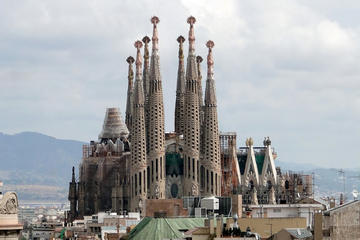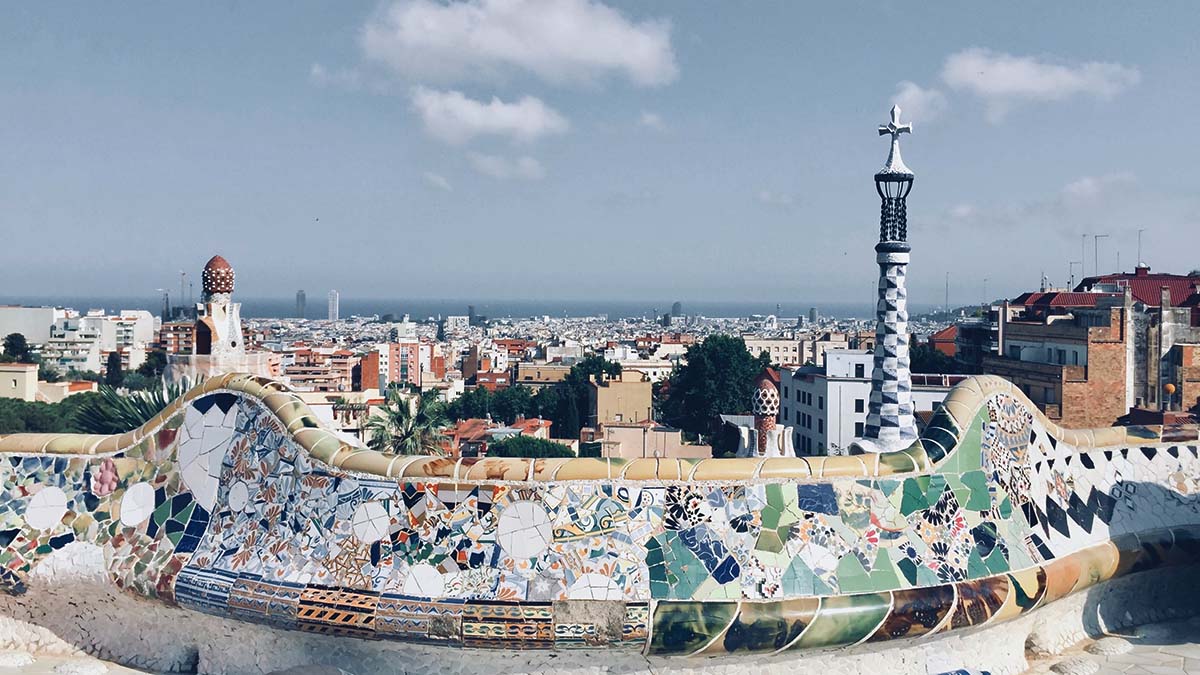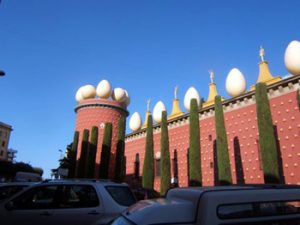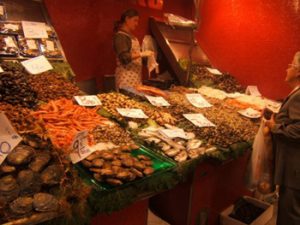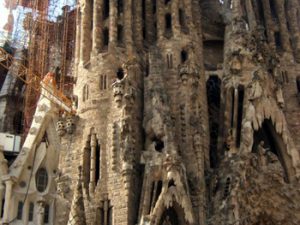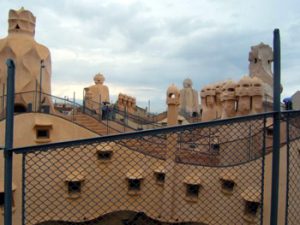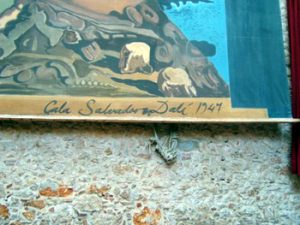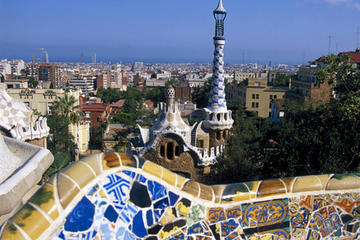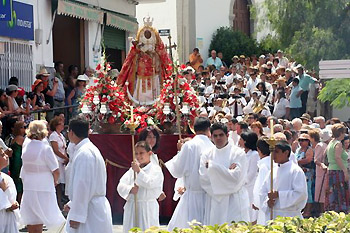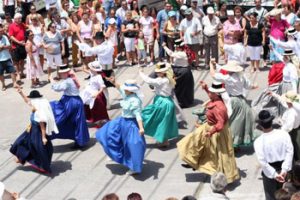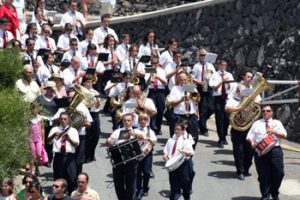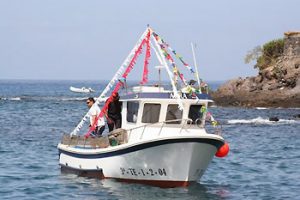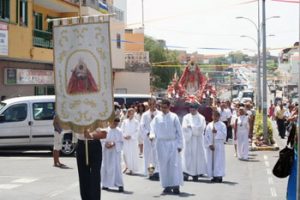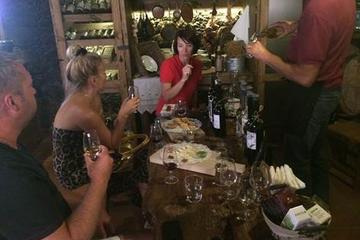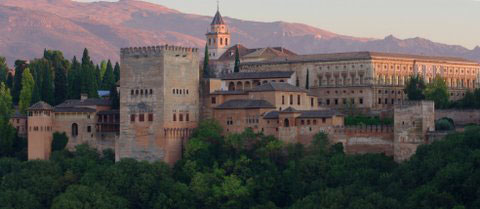
Granada, Spain
by Robin Graham
The Moor’s Last Sigh
The most eloquent tribute to Granada’s charm is to be found above it, high in the Sierra Nevada mountains where a rocky pass known as El Ultimo Suspiro del Moro overlooks the city and fortress below. Boabdil, last man standing for the Moors in Spain, turned here to look back at the splendour he had just handed over to the Christian monarchs, Isabella and Ferdinand. Defeated, he let out a cry for his beloved palace, one of the great architectural treasures of Islam.
Not the ideal moment to have one’s shortcomings pointed out, you might think, but when did a sense of timing ever curb a mother’s tongue?
You do well to weep as a woman, she scolded, for that which you could not defend as a man.
You can see why Boabdil might have been overcome – Granada is nothing if not picturesque. Like a lion’s claws resting on grass, a few spurs of the sierra jut forward on to the vega, the huge flood plain on which the later Christian city sprawls. Overlooking these commercial districts, the cathedral, churches, squares and markets, one of the heights is home to the old Moorish city, now known as the Albaicin. Another, on the opposite side of the Darro valley, is crested by the fortified walls and ramparts of the Alhambra.
The Lion’s Den
 The year was 1492 and as they rode into town Ferdinand and Isabella were accompanied by a certain Christopher Columbus, there to seek support for an expedition to the Indies.
The year was 1492 and as they rode into town Ferdinand and Isabella were accompanied by a certain Christopher Columbus, there to seek support for an expedition to the Indies.
They refused him of course, carried away as they were with the conquest of Granada, a defining moment for Christian Spain in the 15th century and the last nail in the coffin for Islam on the Iberian peninsula.
When Ferdinand stepped into the Mexuar hall with Isabella to consecrate it with a Christian mass the palaces were both long-established and newly finished. They might have smelt paint as they meandered through the Palace of the Lions, the most ornate in the royal complex.
Centered around a courtyard of marble columns, fountains and pavilions and completed well within the previous century, it would have been considered a relatively new build.
Constructed in what has come to be known as the Nasrid style, the palace reveals both Muslim and Christian influences. Ironically, this most private of areas within the Alhambra, housing the royal harem and hidden from all other eyes, is the most visually rich and opulent.
Allegories in Alabaster
 Perhaps the royal couple did not pick up on the allegorical design (the original meaning of harem, or al haram, is sanctuary). The four streams of paradise flow from each wing to the central fountain of aforementioned lions. The impression is that of a desert oasis, with the columns lining the courtyard standing in for palm trees.
Perhaps the royal couple did not pick up on the allegorical design (the original meaning of harem, or al haram, is sanctuary). The four streams of paradise flow from each wing to the central fountain of aforementioned lions. The impression is that of a desert oasis, with the columns lining the courtyard standing in for palm trees.
The detail is incredible; just about every surface has been worked to within an inch of its life, but the scale here is human and it’s easy to imagine the space inhabited by a family at rest, or play.
Fantastically adorned halls surround the courtyard, with ceilings of muqarna (an ingenious Lego-like system of ceiling decoration which gives the impression of stalactites), central pools and the customary tiling.
They tell their own stories, from the delightful Lindaraja Mirador where the sultan’s favourite concubine would have day dreamed overlooking the city, to the Hall of the Abencerrajes, where it’s said that thirty-six of the noble Abencerraje family were slaughtered because one of them had slept with her.
Architectural Battleground
 The conquest of Granada was of such importance to Ferdinand and Isabella that they commissioned a royal chapel in the city to house their remains. Visitors can still pay their respects here, just around the corner from the muscular Christian cathedral.
The conquest of Granada was of such importance to Ferdinand and Isabella that they commissioned a royal chapel in the city to house their remains. Visitors can still pay their respects here, just around the corner from the muscular Christian cathedral.
Moorish rule in Spain had come to an end but the new management were left with a largely Muslim population whose loyalties were considered dubious. The work to stamp Christianity on the city and region began in earnest with the building of the cathedral, beginning in 1518.
Wandering around its interior it is impossible not to take the cathedral as an emphatic response to the Nasrid palaces up on the hill. Predominantly white and gold, it couldn’t be further from the intricate, intimate and multicoloured rooms of the Alhambra. Scale and detail are a negative image of Nasrid design; the building is a massive, cavernous space, calculated to invoke fear in the faithful and with a plain finish on most of its surfaces, where the palaces are small and insanely generous in detail.
The Anomaly that Charles Built
 There was to be another brick-and-mortar response to Islam and at much closer quarters, within the walls of the Alhambra itself . When Charles V came to power in Spain, not long after the conquest of Granada, he wanted his residence to be both close to the Nasrid palaces and fit for an emperor.
There was to be another brick-and-mortar response to Islam and at much closer quarters, within the walls of the Alhambra itself . When Charles V came to power in Spain, not long after the conquest of Granada, he wanted his residence to be both close to the Nasrid palaces and fit for an emperor.
The result is the Charles V palace. At a distance it has become an essential element in the Alhambra’s universally recognisable profile. Close-up, it’s an anomaly in both style and size, towering over the Moorish complex as if it had narrowly missed it when landing. It is a Renaissance building, a sixty-three metre square construction on two levels, concealing an inner patio in the surprising form of a circle. Cutting edge for its time it now appears grandiose, juxtaposed as it is with the less intimidating Moorish exuberance of the royal complex.
In spite of the bombast with which the Christians built, or perhaps because of it, the more distant, Islamic Granada has never quite disappeared. Apart from the Alhambra the city is dotted with gates, walls and bath houses from the time of Moorish rule.
A Grudging Respect
 It would appear that alongside the religious fervour that was to culminate in the expulsion of all Muslims from Spain in 1609, there was something of a grudging respect for their culture. On the day they entered Granada, Ferdinand and Isabella wore elaborate Moorish costumes which had been commissioned especially.
It would appear that alongside the religious fervour that was to culminate in the expulsion of all Muslims from Spain in 1609, there was something of a grudging respect for their culture. On the day they entered Granada, Ferdinand and Isabella wore elaborate Moorish costumes which had been commissioned especially.
As recently as two hundred years ago, in the very shadow of the cathedral, stood an ancient Arab silk souk, the Alcaiceria, a gated network of alleys lined with shops in the middle eastern style, coexisting happily with the Christian city around it long after the reconquest of Spain. It’s gone now, burnt down in the 19th century and quickly replaced by a parody of itself, catering exclusively to tourists looking for some Moorish tic-tac to take home or the pilgrim after some religious kitsch.
It isn’t just in architecture, however, where the two cultures have battled and, occasionally, embraced. Granada still has its souk.
Tea for Two Cultures
 Walking up the Caldereria Nueva, a sloped street in the lower Albaicin and within sight of the Alhambra, you could be forgiven for thinking you’re not in Spain at all. That or you are, but it’s the middle ages. The narrow street is lined with souk style North African merchants and Moroccan teterias, or tea houses. The owners sit outside their shops at the quieter times and gossip here as they do in Fez, Cairo and Damascus. From the teterias the aroma of minted tea is accompanied by that of the sheesha, or water pipe. Arabic is the lingua franca in this neighborhood, along with French, Spanish and of course English.
Walking up the Caldereria Nueva, a sloped street in the lower Albaicin and within sight of the Alhambra, you could be forgiven for thinking you’re not in Spain at all. That or you are, but it’s the middle ages. The narrow street is lined with souk style North African merchants and Moroccan teterias, or tea houses. The owners sit outside their shops at the quieter times and gossip here as they do in Fez, Cairo and Damascus. From the teterias the aroma of minted tea is accompanied by that of the sheesha, or water pipe. Arabic is the lingua franca in this neighborhood, along with French, Spanish and of course English.
Too easily dismissed as a show for the tourists, in fact the teterias rely for much of their custom on the city’s muslim youth and on students; Granada is one of Spain’s most popular university towns.
The concentration of shops selling everything from typically Moroccan trinkets to bohemian clothes for the city’s substantial hippy population has given rise to a lively micro-economy of support services, from bakers to barbers; all the result of a considerable influx of North African migrants in recent years.
This is not the latest incarnation of a continuous Islamic presence in the city. The expulsion of Muslims from Spain in the 17th century was absolute. There is no clear line of continuity between the period of Moorish rule and this street or these shop owners.
As difficult as it is to believe, standing here in the souk and staring up at the Alhambra, the two are totally unconnected, resulting from entirely different historical contexts. If any of these merchants are descended from those who traded in Granada before the reconquest, it’s mere coincidence.
A Room with a Historic View
 Coincidence it seems, is to be found at the heart of this city’s defining moments as often as are these two faiths. Across the Darro valley, the Alhambra’s most prominent feature from here is the Comares tower which houses the Hall of the Ambassadors. It’s the most impressive and stately of the rooms a visitor will see on their tour, having just stepped in from the bright light of the Courtyard of the Myrtles, a delight for the ear as well as the eye, its fountains babbling at either end of a mirror smooth pool.
Coincidence it seems, is to be found at the heart of this city’s defining moments as often as are these two faiths. Across the Darro valley, the Alhambra’s most prominent feature from here is the Comares tower which houses the Hall of the Ambassadors. It’s the most impressive and stately of the rooms a visitor will see on their tour, having just stepped in from the bright light of the Courtyard of the Myrtles, a delight for the ear as well as the eye, its fountains babbling at either end of a mirror smooth pool.
The eye needs time to adjust. When this was Boabdil’s throne room the alcoves and windows would have been glazed with coloured panes. He would have had the advantage of his visitors, backlit in many colours while they blinked from the light of the courtyard. It was in this hall that Boabdil would have held council and reached his agonising decision to surrender the city. On January 2nd 1492 he and his royal party rode out to formally hand Granada over to a waiting Isabella and Ferdinand. He was spared the humiliation of kissing their hands, apparently at the insistence of his mother.
It is to this same room just weeks later that a disconsolate Columbus, having once been refused by Isabella, was summoned. Ferdinand would have been bathed in the light that pours through the ornate windows of this Moorish hall, surrounded by the rich Quranic script covering its walls, when he finally agreed to support the adventure, that great leap of faith through which Columbus unwittingly helped create what we now call the West.
After a Long Absence
 Some things change, and some never seem to. The centuries that have passed since Columbus’ voyage have frequently been troubled by encounters between Islam and Christianity, between both and secularism. The ramparts of the Alhambra have withstood. In our times of idealogical clash and religious hatred, the Moorish edifice stands all the more alluring; a testament to the shared history of cultures and faiths, if not reconciled then at least intertwined in the stone and tile work of the Alhambra and in the lives of its occupants.
Some things change, and some never seem to. The centuries that have passed since Columbus’ voyage have frequently been troubled by encounters between Islam and Christianity, between both and secularism. The ramparts of the Alhambra have withstood. In our times of idealogical clash and religious hatred, the Moorish edifice stands all the more alluring; a testament to the shared history of cultures and faiths, if not reconciled then at least intertwined in the stone and tile work of the Alhambra and in the lives of its occupants.
Looking out from the floor level windows of the hall, back across the Darro Valley and the Albaicin, another tower is visible on the opposite height. It isn’t a bastion, nor is it the bell tower of a church; it’s a minaret.
In 2003, on a site that can’t be much more than five hundred metres, as the crow flies, from the Comares Tower, five hundred years of absence came to an end in the form of this mosque. In a country that was once the home of religious diversity, and then could not abide it, the faith of those who built the great wonder that is the Alhambra has once again found a place for itself in Granada.
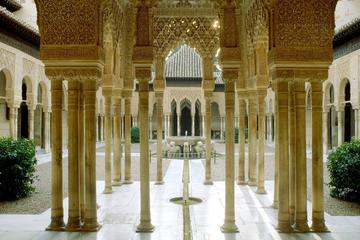
Private Official Guide to Visit Alhambra in Granada
If You Go:
Granada has its own airport and is also served by Malaga airport, a two hour bus ride away.
Tickets for a night visit to the Nasrid Palaces cost €12 per person, or €13 if you book in advance from www.alhambra.org, which you are strongly advised to do. Even in the off season, demand is high. Tickets booked in advance can be picked up at the ticket machines with the card used to make the booking. This way you will avoid queueing (yeah right), or the possibility of not getting in at all! If you are from the EU and are a senior citizen, you pay only €9, whether you book in advance or not, and children under the age of 12 are admitted for free, although you may prefer to take the little ones along on a day visit, when for the same ticket prices you will also be able to visit the Alcazaba (the ramparts) and the Generalife with its gardens, in addition to a time slot in the Nasrid palaces.
If you want to splash out, you could stay at the Parador on the grounds of the Alhambra. Check out availability and rates at www.paradores-spain.com/spain/pgranada.html.
Nearby is another upmarket option, the Alhambra Palace Hotel. Check www.h-alhambrapalace.es.
Downhill, the city itself provides both a huge number of places to stay in all price categories, and a perfect excuse to wander down there after your Alhambra visit for something to eat, and drink. You won’t have to climb the hill afterwards to find your bed.
For luxury try Ac Palacio de Santa Paula on Gran Via de Colon, one of the city’s main streets, Availability and rates at www.palaciodesantapaula.com.
For something more affordable and down to earth, go for El Numero 8 in the Moorish Albayzin, a guesthouse of self contained apartments run on an eco friendly basis in this ancient area of the city. Utterly charming and surprisingly cheap. Check www.elnumero8.com.
About the author:
Robin Graham writes for Travel Thru History, Literary Traveler, Matador and The Expeditioner, among others. He and his fiancee, K, recently threw a dart at a map and as a result now live in Tarifa, Spain. He blogs about it at www.alotofwind.com which has already garnered quite a readership.
Blog: www.alotofwind.com
Photography: www.robingraham.smugmug.com
Twitter: @robinjgraham
All photos are by Robin Graham.

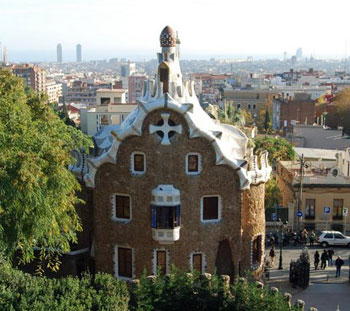
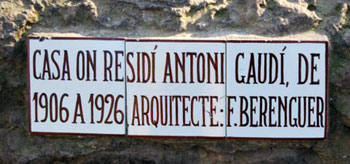 Certainly the buildings were different. Nature, it is said, abhors a straight line. So did Gaudi; the builders, glaziers and carpenters of Barcelona must have hated him. But, we didn’t stop at either of them. We were on our way to the Güell Park, where some of the best of Gaudi’s work is to be seen. Indeed, Gaudi used to live here, in a pink, fairy-tale house which is now the Gaudi Museum.
Certainly the buildings were different. Nature, it is said, abhors a straight line. So did Gaudi; the builders, glaziers and carpenters of Barcelona must have hated him. But, we didn’t stop at either of them. We were on our way to the Güell Park, where some of the best of Gaudi’s work is to be seen. Indeed, Gaudi used to live here, in a pink, fairy-tale house which is now the Gaudi Museum.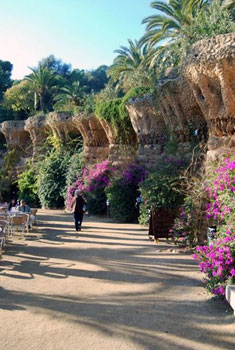 Güell wanted to build a model village, on the lines of similar villages in England, such as George Cadbury’s Bourneville, in the Midlands. But, Cadbury built his village for workers in his chocolate factory. Güell was much more ambitious. He intended his village for the more affluent and influential people of Barcelona.
Güell wanted to build a model village, on the lines of similar villages in England, such as George Cadbury’s Bourneville, in the Midlands. But, Cadbury built his village for workers in his chocolate factory. Güell was much more ambitious. He intended his village for the more affluent and influential people of Barcelona.
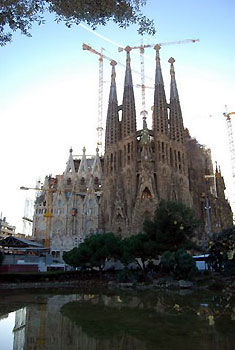 Gaudi was a devout Catholic, and, in his later years, made the building of the Sagrada Familia his life’s work. However, Barcelona already had a perfectly good Cathedral, and this could have been the reason that no money at all came from the Church. The building was founded solely by public subscription. So, construction progressed very slowly.
Gaudi was a devout Catholic, and, in his later years, made the building of the Sagrada Familia his life’s work. However, Barcelona already had a perfectly good Cathedral, and this could have been the reason that no money at all came from the Church. The building was founded solely by public subscription. So, construction progressed very slowly.